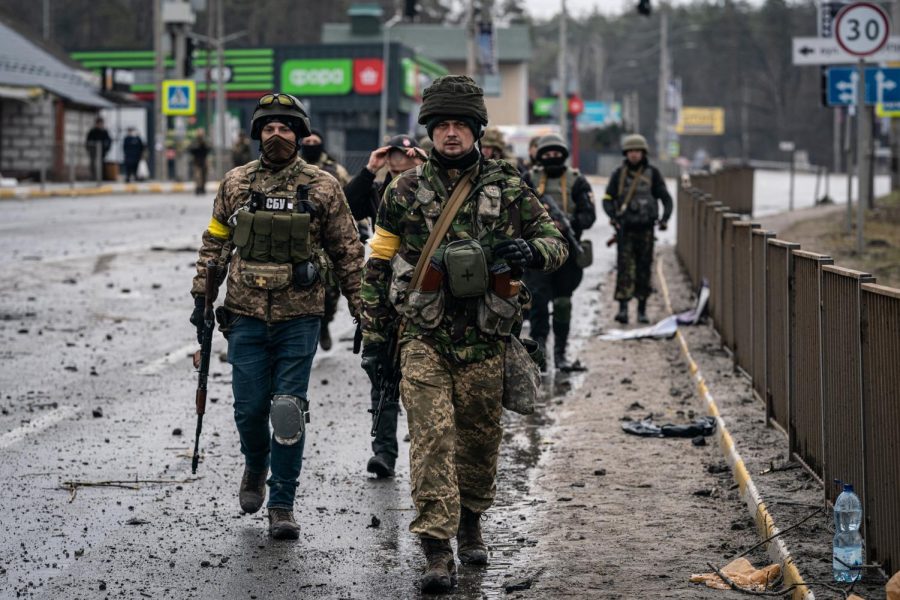The Russia Ukraine War
The Russo-Ukrainian war began like a scene from the Cold War, with Putin’s troops congregating on the nation’s border, raising diplomatic tensions. Since 2021, Russia had amassed a large military buildup, gathering up to 190,000 troops. On Feb. 24, 2022, the atmosphere took a brisk turn as Russian troops launched an offensive into Ukraine.
The military action on the border is effectively the largest mobilization of forces Europe has seen since 1945, following World War II. In the past three months, Russia has launched several offenses into Kyiv, but failed to capture the heart of the city. The troops have tried recapturing several of the nearby cities, resorting to a gradual advance on the capital of Ukraine. However, the Russians vastly underestimated Ukrainian’s resolve to defend their homeland. Even their finely trained military had to combat against the strong morale of the civilians of Kyiv.
The mass bombing, at the same time, has caused millions of Ukrainians to flee the country. Currently, more than 11 million people are believed to have fled their homes since the beginning of the war. Another 6.5 millions people are said to be displaced within the country itself. Out of the 2000 internally displaced people that were surveyed, 30% had come from Kyiv, while more than 36% fled from the East of Ukraine.
In terms of this surging refugee crisis, the United Nations has tried for “humanitarian assistance wherever necessary and possible.” They have been giving cash, delivering supplies, providing folding beds, and set up reception and transit points. As of early May, Poland has taken up almost 3 million refugees, while Romania, Russia, and Hungary are close in the ranks.
Currently, Ukrainian President Volodymyr Zelenskyy’s office claims that it has a planned operation to evaluate civilians from the steel plant crisis in Mariupol. This is one of the last holdouts against Russian forces in the city, and a mass evacuation is underway. The struggle continues as efforts are being made to save the civilians from the steel plant in Azovstal, Ukraine.
Although the U.S. had originally served as more of a cautious ally to Ukraine, recently they have become much more fierce and adamant against Russia. The U.S has switched from a backup ally and aiding from the safety of their home, to now acting as a proxy war against Russia and Vladmir Putin. The main goal now is to weaken Russia enough that a strong enough Ukraine is able to recover and stand strong, eventually driving out all Russian soldiers and advances.
The only issue with this plan as of now is that Biden has no more funds to continue the plan. He has recently asked congress for thirty-three billion dollars. Although costly, this money will be a great aid to the Ukrainian people and will average to around two hundred million dollars a day for the next five months.
America has expressed hopes that once Ukraine is able to beat Russia and become a sovereign nation again that Russia, and especially Vladmir Putin, will calm down and not attempt another war again. This hope and the fear that Putin will not stop at Ukraine has motivated the country to keep pushing through to stop Russia in their tracks.
A new problem as well as the war is the difficulty for countries to purchase gas. Out of all the countries in the world, Russia is one of the biggest gas suppliers. Which is an issue for countries who have been attempting to avoid purchase of gas from Russia. Russia has demanded countries pay for gas in Rubles (the national Russian currency). In response to this, the European Union (EU) has warned its members to resist and not cede to Russia.
The EU has been discussing possible new sanctions to oppose Vladmir Putin and Russia. The EU hopes that eventually these sanctions will be enough to convince Russia to give up and surrender in Ukraine, but this could result in a long battle. This war of attrition not only affects Russia, but also countries in the EU as well. European countries are experiencing increased gas prices as the fuel source becomes increasingly hard to obtain.
Although the war is difficult, the aid of America and European countries have given substantial aid to Ukraine and has allowed Ukraine the time to recover and become stronger than it previously was standing alone against the Russian forces.

Armando is a Senior at Aliso Niguel who loves stepping outside of his comfort zone and is super excited to write for the newspaper for his last year. He...

Akshata is a senior who loves to be creative and put her mind to things. She has been in the newspaper for three years, and is excited to finish her final...









